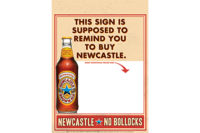Brand It Like Apple
Sarah Theodore
Editor
What do Apple computers,
Starbucks and Target stores have in common? Fabulous branding, according to branchannel.com, brand consultancy
Interbrand’s online publication. Brandchannel recently released the
results of its 2004 Reader’s Choice Awards, and those companies were
among the firms thought to have the most global brand impact.
Thanks to the iPod, Apple achieved 300-percent sales
growth last year. According to brandchannel, there are now more than 10
million “pod-addicts” in the world, and the company created the
iTunes music store to further boost its appeal to music lovers.
Starbucks is both a beverage industry and retail
phenomenon, and it continues to fire on all cylinders. It opened more than
1,300 new locations in 2004, and consistently innovates in both its product
lineup and the services that make its stores so popular.
The Seattle-based coffee company was the only beverage
firm to make it on the Top 5 list in North America, but Corona, Bacardi (this month’s Beverage
Industry cover company) and winemaker Concha y Toro all made the list for most influential
Central and Latin American companies. Café de Colombia, the group
that created Juan Valdez, slipped from the Top 5, but still is considered quite influential by branchannel.
Beverage Industry readers
who work with Target won’t be surprised to learn that
branchannel’s assessment of the mass merchandise
retailer was that it makes people feel “smart, savvy and sexy”
for being Target shoppers. Minneapolis-based Target excels at the concept
of upscale, often exclusive products at a reasonable price. I’d have
to add that it’s the same concept that has made Costco club stores
such a success.
So what’s relevant to beverage manufacturers
about the iPod? And why did more big beverage brands not make the short
list? As a recent Cannondale Powe-Ranking survey pointed out, branding and
innovation strongly affect the way retail customers think about food and
beverage companies.
The survey reported one retailer’s frustration:
“Food companies are very good at what they do. But we’re in a
period of relative stagnation where there isn’t anything really
exciting taking place in the market. The best example of this is the whole
low-carb phenomenon. We’ll look back on this as one of the biggest
wastes of manufacturing resources and time that has happened in the last 10
years. If the hundreds of millions or perhaps billions of dollars spent to
introduce low-carb items were invested in other areas to create some really
innovative new products, just think of the long-term effect on the food
business.
“On the other hand,
if you look at what is happening on non-foods, these manufacturers have had
to innovate because their categories were stagnant... If you want to know
where innovation is coming from right now, it’s coming from
non-foods.”
Do you have an iPod in
your lineup? What are the areas of the beverage industry that still have
potential for true brand impact? Perhaps a look at another industry can be a great source of
inspiration.
Sneak Peek
Sneak Peek
| March |
| Dr Pepper/Seven Up Bottling Group’s |
| Jim Turner |
| Category Focus — Annual soft drink report |
| Packaging — Mass merchandiser packaging |
| Marketing — Seasonal marketing |
| Beverage R&D — R&D testing equipment |
| April |
| Category Focus — Wine & spirits |
| Marketing — C-store strategies |
| Packaging — Annual packaging report |
| Beverage R&D — Sweeteners |




